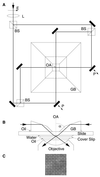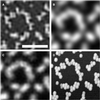True optical resolution beyond the Rayleigh limit achieved by standing wave illumination
- PMID: 10840057
- PMCID: PMC16528
- DOI: 10.1073/pnas.130181797
True optical resolution beyond the Rayleigh limit achieved by standing wave illumination
Abstract
During the last decade, various efforts have been undertaken to enhance the resolution of optical microscopes, mostly because of their importance in biological sciences. Herein, we describe a method to increase the resolution of fluorescence microscopy by illuminating the specimen with a mesh-like interference pattern of a laser source and electronic postprocessing of the images. We achieve 100-nm optical resolution, an improvement by a factor of more than 2 compared with standard fluorescence microscopy and of 1.5 compared with confocal scanning.
Figures




References
-
- Born M, Wolf E. Principles of Optics. New York: Pergamon; 1980.
-
- Sheppard C J R, Choudhury A. Acta Opt. 1977;24:1051–1073.
-
- Brakenhoff G J, Blom P, Barends P. J Microsc. 1979;117:219–232.
-
- Stelzer E H K. J Microsc. 1997;189:15–24.
-
- Sandison D R, Piston D W, Williams R M, Webb W W. Appl Opt. 1995;34:3576–3588. - PubMed
Publication types
MeSH terms
LinkOut - more resources
Full Text Sources
Other Literature Sources
Molecular Biology Databases

